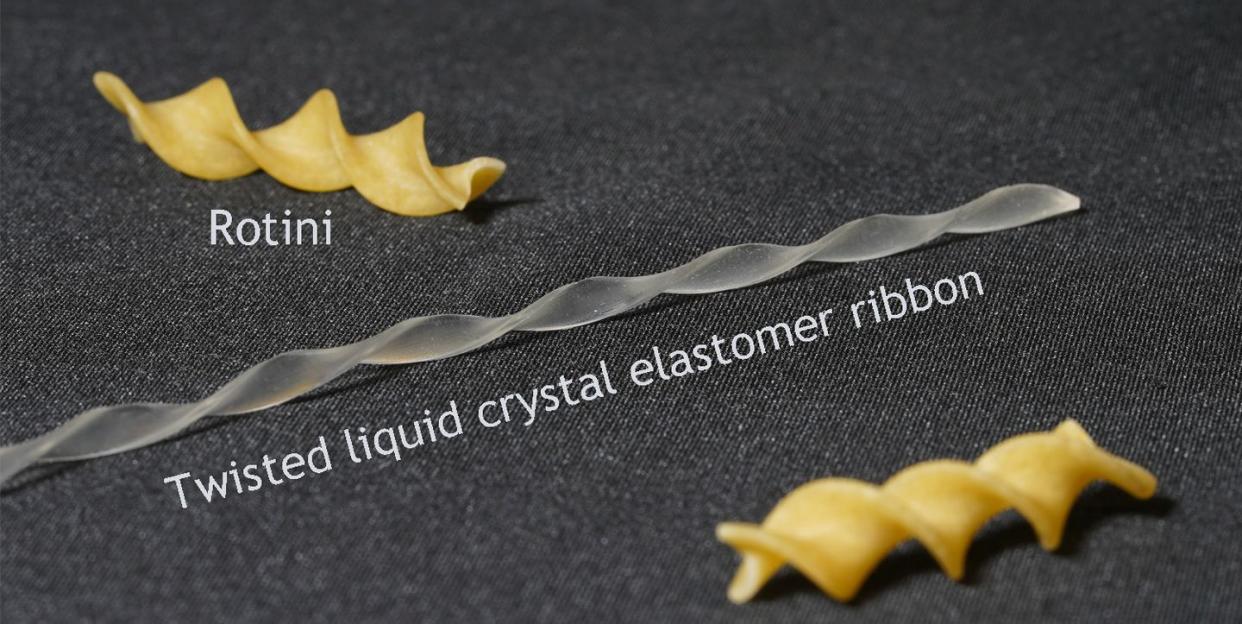Watch This Pasta-Shaped Robot Twist Itself Through a Maze

The ribbon shape of this robot enables it to navigate complex environments without any motors, circuits, or computer communication.
Its simple rolling movement and energy storage capability makes it ideal for exploring tight spaces.
The robot is made from liquid crystal elastomers, which use heat in the surroundings to power movement.
It looks like stretched-out plastic rotini. Or maybe extended fusilli. But no, the soft, clear noodle you see in the video above is not made of pasta, it’s actually a robot. Except, it has no motors, no circuits, and no computer to tell it what to do.
Instead, the shape rolls, bends, and snaps back as it navigates around obstacles in mazes on different surfaces. It gathers and stores heat energy from its environment as it moves, using that energy to power its movements.
🤖 You love robots. So do we. Let’s nerd out over them together.
The ribbon robot is made of liquid crystal elastomers, a rubbery “smart soft” material that can move as it heats up. Simply placing it on a surface that’s 131 degrees Fahrenheit gets the robot to do the twist, and it starts rolling. This works because only the bottom part of the ribbon that’s touching the hot surface contracts, and the rest does not, prompting a rolling motion, Jie Yin, a mechanical and aerospace engineer, explains to Popular Mechanics in an email. He’s one of the researchers at North Carolina State University involved in the work. “This generates both an axial force and a torque. The axial force bends the soft body slightly, while the torque flips the soft body to drive it move forward,” he says.
Once it encounters an obstacle, the ribbon robot starts rotating around it by continuing the twist-and-roll movement. However, if it struggles, the robot starts bending in the opposite direction, building up interior tension as it forms an arc. A few things are happening here. The ribbon heats up and starts to untwist, storing energy like a spring, Yin explains. And when the stored energy gets high enough, it “snaps,” rapidly releasing the energy it stored as it deformed.
The snap causes the ribbon to jump a bit and land in a slightly different position, like when you press your fingers on a spring and then take them off. From this position, it automatically starts rolling in the opposite direction, away from the obstacle. “When it is snapped, its body shape is flipped to move away from the obstacle, thus to avoid obstacle intelligently without any computer or human controls,” Yin says.
The robot eventually got around all obstacles in a series of maze experiments, according to a press release. The work was published in the Proceedings of the National Academy of Sciences on May 23.

However, a straight rod made of the same material can’t get around obstacles, because it merely spins in place when it’s stuck, Yin explains.
These soft robots demonstrate a concept called “physical intelligence,” according to Yin. That means it does not move randomly. “Its movement follows the bending direction of its body, i.e., always self-roll toward the direction away from its bending center.”
When encountering an obstacle, it heats up more since its motion is blocked. From there, the robot starts to untwist, like a spring that stores energy in its body. When the stored energy is high enough, it quickly snaps with the help of obstacles to release the energy. When it is snapped, the robot’s body shape flips to move away from the obstacle, thus avoiding obstacles intelligently without any computer or human controls. This is called physical intelligence.
Because they can navigate complex environments, these unusual robots could be used to explore tight spaces that larger robots couldn’t get into, according to the scientists who developed it. They could also be prototypes for soft robots that “are capable of harvesting heat energy from natural environments and autonomously negotiating complex, unstructured settings such as roads and harsh deserts,” Yin says in the news release.
You Might Also Like

